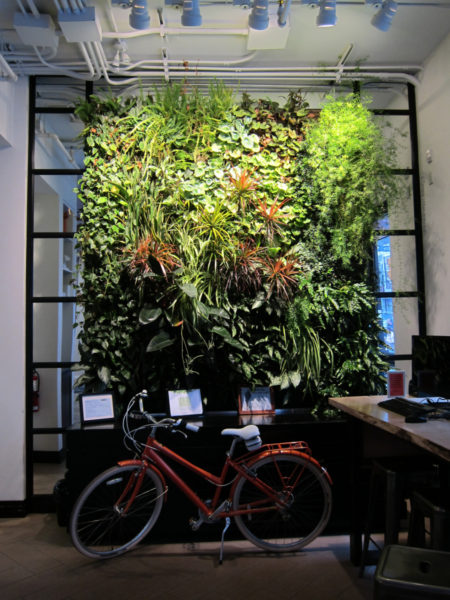Maintenance is one of the most important aspects of making sure your landscape project survives- both literally and figuratively! When designing green walls, one key consideration is how a maintenance team is going to reach all of the parts of the garden. Many standard maintenance procedures for vertical gardens are the same as for any piece of landscape architecture, but there are a few things that may catch you off guard…
 Green Wall on Le Pont Juvénal, Août 2008. Image © Patrick Blanc
Green Wall on Le Pont Juvénal, Août 2008. Image © Patrick Blanc
Many vertical gardens are maintained by someone other than the building owner. Various vertical garden distributors offer maintenance packages that cover differing amounts of time. If a maintenance contract is signed, it is very important that the duration and scope of the work is well defined. Many vertical garden companies will send employees to the site to perform maintenance, but sometimes it is also necessary for one site maintenance staff to check systems themselves. At times like these, that the maintenance contract must be explicitly detailed.
 TedCo Green Wall by Nedlaw Living Walls. Image courtesy of Nedlaw Living Walls
TedCo Green Wall by Nedlaw Living Walls. Image courtesy of Nedlaw Living Walls
The Growing Green Guide outlines the regular maintenance procedures necessary to ensure a healthy vertical garden. The guide is organized into the following categories: establishment, routine, cyclic, reactive/preventative, and renovation maintenance. Each of these categories include various aspects that must be considered:
Well maintained vine system. Designer unknown. Toronto, Ontario. Image © Tamara Urben-Imbeault
- Establishment maintenance refers to the maintenance procedures necessary within the first year or two after construction is completed. During this time, tasks such as pruning, weeding, and irrigation checks are vital to ensure that the outcome remains true to the design intent.
- Routine or recurrent maintenance is an outline of things that have to be done in order for the garden to maintain a satisfactory image. This may include weeding, pruning, and removal of trash.
- Cyclic maintenance is scheduled less frequently than the above. The sole function of cyclic maintenance is to ensure that vertical garden infrastructure (including the building facade) is secure and that all associated safety standards are met. This may also include pruning.
- Reactive and preventative maintenance occurs when a part of the system fails or is showing signs of immanent failure. Failures are often caused by an extreme weather event (such as flooding) or from a long-term problem that has gone unnoticed (like roots blocking drainage holes for example).
- Renovation maintenance includes work that changes the desired aesthetic of the wall itself. This often occurs after a change in ownership, or when a failing design is either removed or remodeled.
The above list is all fairly standard in landscape design, but one of the most unique aspects of maintaining a vertical garden versus one on grade is the height difference. Crews will often need additional tools to reach most of the garden. Sometimes a cherry picker is used, but in the event of gardens being beyond the reach of even the largest cherry picker, a suspension system may be used. In some cases, individual suspension similar to those used for rock climbing is used.
 Vertical Garden irrigation tray detail at ING Direct Cafe, by Green Over Grey. Image ©Tamara Urben-Imbeault
Vertical Garden irrigation tray detail at ING Direct Cafe, by Green Over Grey. Image ©Tamara Urben-Imbeault
The irrigation systems used in vertical gardening are a vital part of keeping the wall alive. As such, irrigation systems need to be checked regularly, and nutrients need to be monitored. If other renovations are being performed on the building, it is vital that the contractors are notified of the vertical garden to ensure their work doesn’t inadvertently damage it- for example, if water related repairs are scheduled and water must be turned off for an extended period of time, scheduling a time to turn the water back on temporarily will help to ensure that the wall doesn’t get too dry.
Plants themselves also have be pruned and monitored for disease. If plants die, new plants must be planted and old ones removed as not to impact the aesthetic of the wall or to cause a fire hazard. Fire hazards in vertical gardens are rare, as long as dead fall is removed as a part of regular maintenance.
 Unkempt Vines at the University of Manitoba’s Faculty of Engineering building. Image © Tamara Urben-Imbeault
Unkempt Vines at the University of Manitoba’s Faculty of Engineering building. Image © Tamara Urben-Imbeault
If vines are involved, must be trimmed once or twice a year, to prevent growth over windows or other undesirable places.
Keep tuned for the next post in our Vertical Gardening Series, entitled “Vertical Gardens in the Backyard”!
PLEASE NOTE: This article is not a complete guide to caring for your vertical garden. Always follow manufacturer and/or designer’s instructions. This post is simply a small glimpse of the maintenance you can expect with a vertical garden, it is by no means a comprehensive guide.
Leading image: Vertical Garden at ING Direct Cafe, by Green Over Grey. Image ©Tamara Urben-Imbeault
Written by Tamara Urben-Imbeault, M.L.Arch. student at the University of Manitoba, Winnipeg, Manitoba, Canada. She is currently working on her design thesis entitled “Vertical Gardening in Cold Weather Climates”
Contact: umurbeni[at]myumanitoba.ca or t.urbendesign[at]gmail.com
Source:
State of Victoria Department of Environment and Primary Energies (2014). The Growing Green Guide for Green Roofs and Vertical Gardens in Melbourne and Victoria. Retrieved from http://www.growinggreenguide.org/wp-content/uploads/2014/02/growing_green_guide_ebook_130214.pdf











Felicity Waters
Hi Tamara – great article.
Vertical gardens have had an amazing impact on the non garden population. They really have been a game changer. I suppose what makes vertical gardens very different from other ‘garden types’ is the ability of the ‘Super Star’ vertical garden installers to secure long term maintenance contracts. Really every garden type should receive the same amount of love. For some reason, in Australia anyway, we design and walk away. Maintenance is not really an issue that extends beyond the defects liability period of a project. Securing maintenance for a landscape design for 5 to 10 years is sheer brilliance.
Maintenance should always be assessed when costing vertical gardens. A vertical garden product may be selected because it offers cheaper up front costs but be wary. The cheaper products tend to lead to a rather expensive garden over time. Recently an Australian designer released a product that will significantly reduce the maintenance implications of a water based vertical gardens. http://www.verticalgardenonline.com.au/podplants/ This is a great break through. New technologies are certainly reducing the ongoing costs of keeping a vertical garden looking great but sadly the upfront costs are more. Swings and round-a-bouts!
Peter
Great read. Thank you for sharing! landscaping sault ste marie